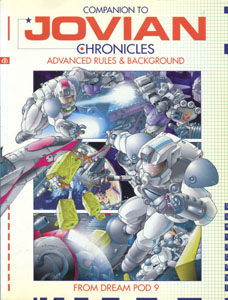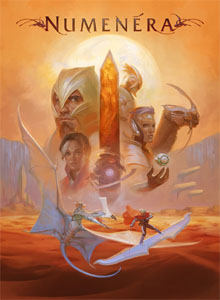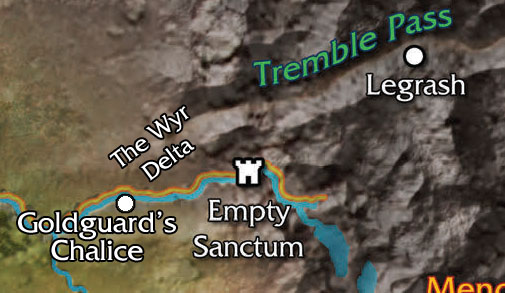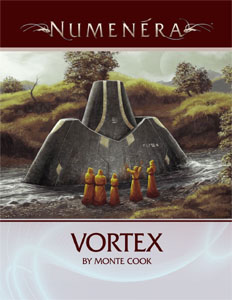Tagline: As a general rule I dislike “companion” volumes. The Pod proves me wrong again. Is anybody really surprised?
 I’ve been reading Dream Pod 9 products since the summer of 1997, when I picked up a copy of the first edition of Heavy Gear. I have written more reviews of Dream Pod 9 products for RPGNet than any other publishing company (my first review here, in May of ’98, was for The Paxton Gambit, a Heavy Gear campaign supplement). The only reason for this is because I have probably read almost as much material put out by Dream Pod 9 as I have for much of the rest of the roleplaying industry combined over the past couple years. And the only reason that’s true is because no other company in this industry can claim the same pattern of constant, consistent success. There have been, in the decade during which I’ve been an active part of this hobby, only a handful of game lines whose products I have picked up without even bothering to glance through them – because I know there is a guarantee of quality from them (most of those lines don’t last on the list very long, either). Dream Pod 9, however, is the only company to get on that list.
I’ve been reading Dream Pod 9 products since the summer of 1997, when I picked up a copy of the first edition of Heavy Gear. I have written more reviews of Dream Pod 9 products for RPGNet than any other publishing company (my first review here, in May of ’98, was for The Paxton Gambit, a Heavy Gear campaign supplement). The only reason for this is because I have probably read almost as much material put out by Dream Pod 9 as I have for much of the rest of the roleplaying industry combined over the past couple years. And the only reason that’s true is because no other company in this industry can claim the same pattern of constant, consistent success. There have been, in the decade during which I’ve been an active part of this hobby, only a handful of game lines whose products I have picked up without even bothering to glance through them – because I know there is a guarantee of quality from them (most of those lines don’t last on the list very long, either). Dream Pod 9, however, is the only company to get on that list.
I love this company. Their books have their flaws (they’ve only recently managed to get past a bad year or so in which all of their products were critically flawed by typos, and their prices have only recently begun to synch up with the rest of the industry), but those flaws are always outweighed by the immensely positive aspects of their books.
But there comes a point when you begin to set out challenges for yourself. “Nobody can be this good all the time,” you think. So you begin to go out of your way to find products you won’t like, just to prove that they aren’t completely infallible. You begin looking at the earliest stuff they produced, for example… and find that, although it’s not as good as the stuff they’re turning out now, it’s still great-to-excellent.
Those of you who have read some of my previous reviews of Pod products may have stumbled across the reviews I did of the Heavy Gear Character Compendium and the Jovian Chronicles GM Screen. In those reviews I discuss the intense dislike I have for the common methodology behind character compendiums and GM screens, and then go on to explain why the Pod succeeded where other’s had failed.
Which brings me to the Companion to Jovian Chronicles (henceforth, the Companion). Companion volumes, like character compendiums and GM screens, are generally products which I avoid like the bubonic plague at the height of a medieval summer. They generally fall into one of two traps:
The first type of companion is the “Whoops, Did We Forget That Vital Rule? Oh Well, We’ll Charge You Twenty Bucks For It!” variety. These companions have all the rules, background information, and other vital information which should have been in the core rulebook, but were left out (either deliberately to bilk the customer, through clumsiness, or through lack of playtesting).
The second type of companion is the “Everybody Else Is Doing It!” variety. Here the only comprehensible reason for the companion to exist is because the line editor sees that other companies have companions for their games and, therefore, his game Must Have One Too!(TM)
Ultimately both of these types of companions suffer from a crippling flaw: They’re just a mishmash of generally useless material (in the former case because the “vital material” only takes up a fraction of the space necessary to fill a book; in the latter because there’s really nothing to put there anyway except odds-and-ends). The book doesn’t really have any firm methodology, and has no real purpose for existing. It’s not adding value to the game line and, once you own it, you’re not really sure why you do.
Then, of course, there are the sub-species of “Player Companions” and “Game Master Companions”. They are their own, highly specialized, sins which serve to blight the shelves of my local gamestore.
So, as a general rule, I dislike companion volumes to games.
Is anybody going to be really surprised if I tell you that, with the Companion, the Pod has proven me wrong once again?
The important difference that sets this book apart from the rest is all in the subtitle: “Advanced Rules and Background”. Or, more specifically, the first word of the subtitle: Advanced.
Advanced in the sense that they’re supplementing their rule system – not patching holes.
Advanced in the sense that the background material they’re presenting is of a highly specialized nature (but extremely useful for those specific, advanced needs).
Advanced in the sense that everything in the book has a clear-cut purpose and utility. You don’t end up with a new set of sub-systems because it would be “really cool” to have them, but because there is a perceived need for them in (again) highly specialized circumstances.
In short, where your typical companion volume is out of focus, this one is tightly focused. It knows what it wants to do, and accomplishes it with laser-like accuracy.
CONTENT
History. The first section of the book is a detailed history of the Jovian Chronicles setting – starting in the late 20th century and going up to the latter months of 2210 (the default start date of the campaign). In the core rulebook this history was presented as an abbreviated one page timeline, while most of the setting material was presented in a planet-by-planet nature (detailing current events).
This fits right in with the “advanced” nature of this book. Current information, such as that found in the core rulebook, is immediately useful for GMs approaching a setting for the first time. As you delve deeper into the setting – as you begin to advance your play – it becomes necessary to understand not only what the world is like, but why the world is like that. In other words, background. History.
My one complaint with this section is the complaint which has plagued my other Jovian Chronicles reviews: Reuse of text. Specifically, one of my complaints regarding the core rulebook was that the Odyssey was not given enough information. The Odyssey was a major sequence of political and military events which took place just before the default start date and had massive impacts at every possible level of the campaign setting. Despite this, it was summarized in 3-4 paragraphs which failed to communicate clearly what exactly had happened.
My problem here? Those exact same 3-4 paragraphs are reused to describe the Odyssey. Frustration city.
Advanced Character Design. Next up we have a suite of advanced character creation tools. In your average companion volume this takes the form of a couple additional skills, maybe some blithe comments of pseudo-babble about how to create characters with real “meaning”.
Not so here. First, you get some genuinely useful comments about designing character personalities which are not only original, but also useful additions to the campaign. Mainly this is because they don’t just throw “happy thoughts” in your direction, but give you some real, solid building blocks to work with.
Next, they add an entire system of perks and flaws to the basic character creation system. Essentially you can spend skill points on perks, or pick up additional skill points with flaws. (Plus, if you recall from the core rulebook, unspent character points can be converted to skill points – so essentially you can tap both your point pools for this system in a sort of trickle down effect.)
After that we get some additional career packages (which are useful tools for GMs who need to quickly generate NPCs, or for players who want a quick-start method of getting the character they want). Then you round out the section with “Military Forces of the Solar System”, providing a one page summary of organization, military culture, ranks, and awards for the Jovian Armed Forces, Venusian Home Defense Force, CEGA Naval, CEGA Army, Martian Free Republic Rangers, and the Martian Federal Army.
Again, note the manner in which everything in the section is useful – but useful in a sense which doesn’t make you feel like the proper place for the material would have been in the main rulebook. It is the clear differentiation of this material as being for “advanced” use, rather than just hole plugging, that makes this an effective product.
Additional Background. Probably the weakest section of the book, the “Solar Nations” chapter provides additional information about each of the major powers in the setting (including a full color page for each). Basically the material expands the background information found in the core rulebook. The only real problem I have with it is that there isn’t enough expansion (only a total of two pages for each power) to really justify it’s existence. A basic understanding is provided by the core rulebook, and adding little drips and droplets doesn’t really improve things – only a sizable addition would do that (i.e., a complete sourcebook for the power). Nonetheless, there’s good, solid, original material to be found here. The most valuable bit being a page which clearly spells out the diplomatic relations between the powers as tensions begin to rise across the solar system.
Advanced Rules. The advanced rules present more detailed systems for handling some specific tasks within the Jovian Chronicles universe: Drug Addiction, Atmosphere, Diseases, Gravity (Falling, etc.), and Radiation. Also, additional tactical rules: Aircraft Manuevers, Firestarting, Hull-Down Positions, Remote Control, Spacecraft Manuevers (Gravity Whipping, Coasting, Hyperthrusting, etc.), Advanced Terrain (Bridges, Roads, Railroads, etc.), Space Environment (Planetary Rings, Radiation Belts, etc.), Weather and Hostile Conditions.
While running the risk of sounding like a broken record, let me say again the thing that makes this effective is that these are not necessary rules. But they are useful rules.
Vehicle Construction System. Finally you can round this book off with the acclaimed Silhouette VCS. This I is, essentially, Version 2 (the first version was found in the first edition of Heavy Gear; the third version is found in the second edition of the Heavy Gear Technical Manual) – but very little besides minor tinkering has been done to it.
The VCS is an effects-based system, which allows you to build pretty much anything you can imagine with great effectiveness. A few of the steps are math intensive, but nothing too serious. The system also features exploded sub-systems – at the most basic level you choose from a list of options; at more advanced levels you generate new options.
MISCELLANEOUS COMMENTS
A few things of minor importance which caught my interest: Take a gander at the dedication on page three. Any company which has enough humor to actually write, “Brough to you by the letter T” gets high marks in my book.
The color section is absolutely breathtaking. Ghislain Barbe is definitely somewhere in my Top 5 list for Best Illustrator in the Industry (and perhaps out of it). His technical skill is surpassed only, perhaps, by the imaginative scenes which he sets down on the paper – capturing both the reality and the spirit of the settings he works on.
That being said, I have to bring up my other repetitive complaint about the Jovian Chronicles product line (I mentioned recycled text above): Recycled art. There are several major pieces reused throughout this text, and many of them are either repeated from the GM screen here or from here to the GM screen. You can usually get away with some minor pieces, but we’re talking some pretty major pieces here (such as the fact that the image from the back of the GM screen puts in two distinct appearances here – once as one of the three panels on the front cover, and again on the interior as a chapter header).
Other nice touches: The recommended reading list of both fictional and non-fictional resources. I’ve made major in-roads on both lists and I must say that it is a fine selection of research texts (which helps explain why Dream Pod 9’s science is so good – they’ve put in the time to get it right).
The book also contains errata for the rulebook and the Mechanical Catalog (there’s about a dozen items total between the two).
CONCLUSION
If you’re running a serious Jovian Chronicles campaign than I can do nothing but heartily recommend this book. It is possessed of some mild flaws, but these are vastly overpowered by the wealth of useful material you will find here. Undoubtedly the best companion volume you’ll find for any game.
Style: 4
Substance: 5
Author: Marc A. Vezina (Phillippe Boulle, Elie Charest, Tyler Millson-Taylor)
Company/Publisher: Dream Pod 9
Cost: $24.95
Page Count: 152
ISBN: 1-896776-17-5
Originally Posted: 1999/10/23
If you’re tracking the dates these reviews were originally posted to RPGNet, you may notice a big gap between this review and the previous one. The reason for this was that I was starting my sophomore year of college. About a week after that previous review was posted, the University of Minnesota Theater Department held their auditions for the season and I was cast in every available show. (This was a marked contrast to the year before where I had struggled to locate the audition notices — which were almost literally filed under a sign saying “Beware of the Leopard” — and then been essentially laughed off the stage the first time I auditioned for one of the shows in the department. But that’s a story for another time.) In addition, my freelance writing career was beginning to take off.
Long story short, I was busy, busy, busy. I managed to slip this and a few other reviews inbetween shows in October, but then there would be another long break until early 2000.
For an explanation of where these reviews came from and why you can no longer find them at RPGNet, click here.















